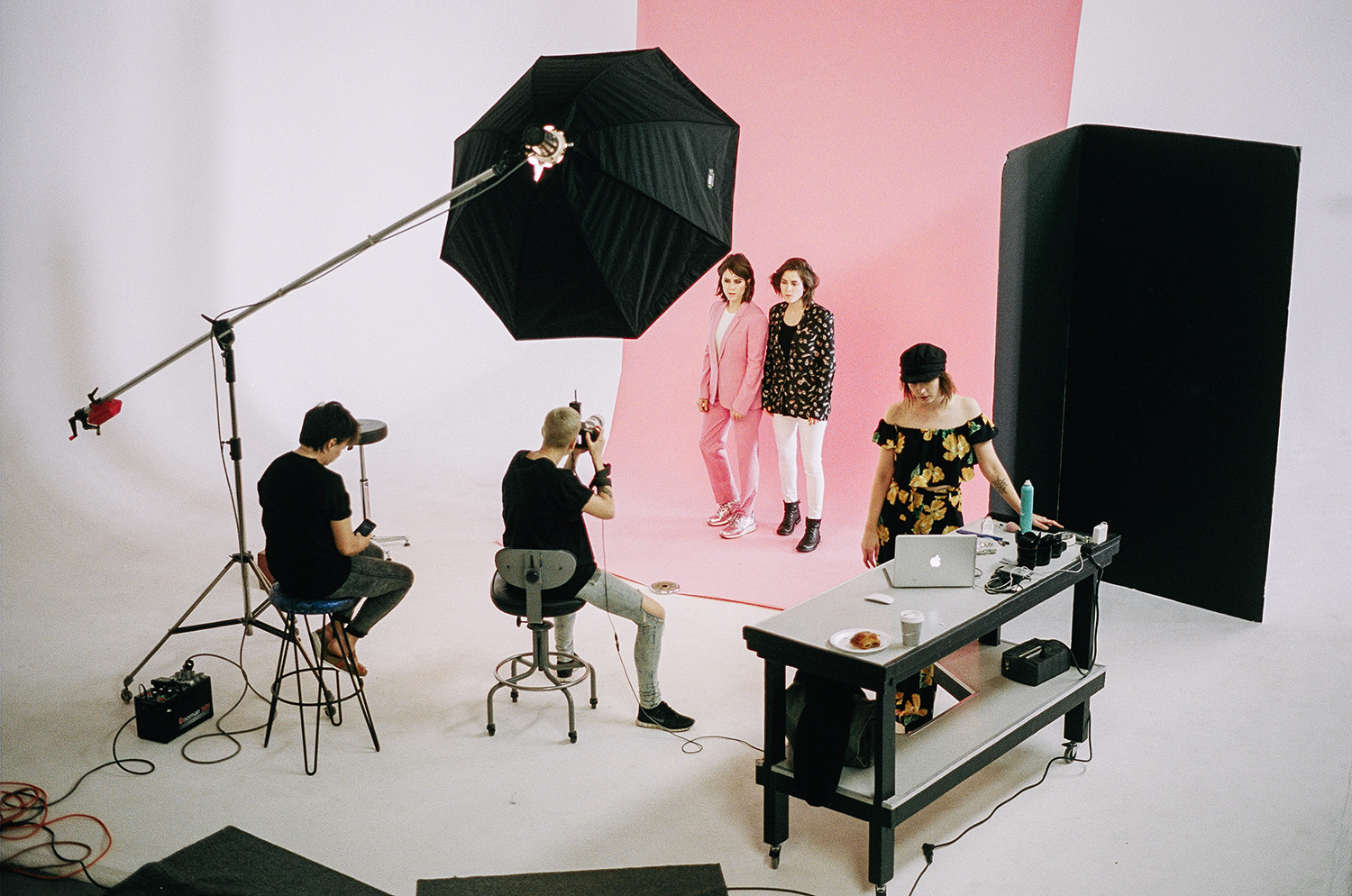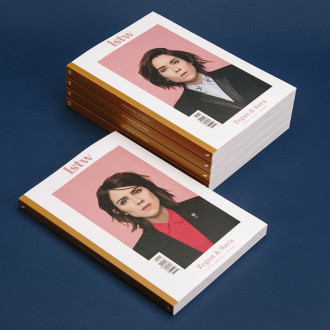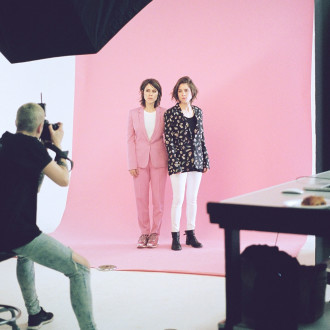Tegan and Sara are using pop’s platform to bring their message—and their queerness—to the masses
TWO MINUTES, MAYBE THREE. That’s how long it takes Tegan and Sara Quin, quick with a joke and a smile, to win over the half-dozen women assembled to take their picture in a studio off Los Angeles’s Santa Monica Boulevard. But they don’t stop there. For the next five hours, surrounded by racks of clothing and platters of Mexican takeout, they roll out a take-no-prisoners charm offensive. A Snapchat tutorial is held, restaurant recommendations shared, and compliments dispensed about the makeup that’s being applied, the outfits that are being pulled and the photos that are being selected. They’re the perfect hosts, even though they’re the guests. An anecdote is told about Mickey— one of Sara’s two Internet-famous cats and the subject of copious amounts of fan art—who, the previous evening, had taken a flying leap from the deck of the Silverlake home Sara shares with her girlfriend, Stacy Reader. The tale of the feline’s daredevil dive is met with dismay, but Sara is quick to reassure the worriers: “As long as cats right themselves when they’re falling, their legs take the impact upon landing.”
It’s as good a metaphor, and jumping-off point (thank you, Mickey), as any. Casual listeners and dismissive music writers have tended to focus on the “novel” elements of the Quins’ biography—Canadian, identical twins, both queer—and left it at that. But 36-year-old Tegan and Sara are, unsurprisingly, more complex than those three points allow. After all, they’ve been performing and creating together professionally for almost two decades. In that time they’ve put out eight studio albums—including their latest, Love You to Death, released in June—and moved from acoustic punk to indie rock to shiny pop. They’ve grown up, grown apart and reconnected. By living in separate cities—Montreal and New York for Sara and Vancouver for Tegan, though they’re now both based on the west coast—and allowing each other time to work on solo projects, they’ve learned that letting go can be just as powerful as holding on. In short, they’ve taken enough leaps, and have regained their equilibrium enough times, to handle the impact.
REWIND FIVE YEARS, give or take. After Sainthood, the duo’s sixth offering, Sara realized she needed something to change. She wanted their music to be something different; it had started to feel inauthentic. For her part, Tegan dreamed of topping charts and playing stadiums. The solution: Heartthrob, a synth-pop nugget released in early 2013 that stabbed a stake through their indie cred and vaulted them into the mainstream. The album debuted at number three on the Billboard 200, a personal best. A few months later, they appeared onstage at a Taylor Swift show; less than a year after that, they toured with Katy Perry. (The twins’ talent seems to be the one thing the feuding stars can agree on.) The transition was complete.
That’s not to say it was seamless. While Heartthrob snagged Juno Awards, a Polaris Prize nomination and critical acclaim, diehard fans struggled with the shift. Despite those growing pains, Tegan and Sara embraced the change—and the potential for ongoing evolution. In February 2015, the sisters performed a beyond bubbly rendition of “Everything Is Awesome” from The Lego Movie soundtrack with The Lonely Island at the Oscars.
Many music writers have focused on the “novel” parts of the Quins’ biography— Canadian, twins, queer—but, unsurprisingly, the sisters are more complex than that.
The pair then doubled down with Love You to Death, which carried them further along the pop path with a tight 31-minute set of Top-40 songs. For Sara, much of the album’s power lies in its authenticity. “I don’t listen to the same music I listened to when I wrote our pre-Heartthrob records. I don’t live in the same city, or even have a lot of the same friends. I have different influences and influencers in my world right now, and so this makes complete sense. If I were writing acoustic guitar songs and making indie rock records, I would be faking it.”
Her sister cautions against greasing the squeakiest wheels, that fervent and vocal online contingent fond of telling the duo they’ve sold out. “A lot of people have stuck with us and we’re committed to keeping up a dialogue with our fans,” Tegan says. “So it’s unfortunate that a very loud few seem to speak for everyone on social media. Our joke is that Sara could rescue 30 kittens from a burning treehouse, post a photo on Instagram, and they’d be, like, ‘She’s growing her eyebrows out.’
TEGAN AND SAR A MAY be done tracking who loves them—and how much—but there’s no question their base is expanding. Thanks to The Lego Movie, grade-schoolers can now include the band in their list of everything that is awesome. And judging by the May 2016 GQ article “Meet Tegan and Sara, the Women Whose Haircuts You’ll Want Next Year,” the men’s monthly has taken a bullet train to fandom via fashion.
This attention isn’t entirely new for the duo: years in indie rock circles led to recognition, though it wasn’t without its issues. “As we became more popular, it was confusing to be accepted by the old guard of mainly white, heterosexual indie rock guys, because they wouldn’t necessarily speak out in support of us,” says Tegan. “We were in the scene but always on the periphery.”
Being marginalized often (usually) goes hand in hand with being condescended to. In 2000, the sisters bought computers and ProTools so they could record and produce on their own. But that didn’t discourage male collaborators from trying to exert influence or even, in the case of one producer who took a meeting for Heartthrob, offering to show them how to use a volume knob on a headphone. (Spoiler: he didn’t get the job.) “It took a lot of years and a lot of apologizing for us to get to this place. We’re very respectful and we’re very humble, but we don’t apologize anymore,” says Tegan.

IF TEGAN IS TO be believed, mainstream artists have really good cookouts. Like, no-bug, no-rain bashes where the drinks flow and the food is always grilled to perfection. Spending time in the mainstream is basically like being at one long Taylor Swift Fourth of July party.
“Somehow we’ve managed to open the gate and walk over to the barbecue that’s happening on the other side to hang out with a different scene of people,” she says. The invite is extended and accepted with eyes open. “The people at that barbecue understand that by supporting us, they can get their subversive message out there. Katy Perry doesn’t say ‘Welcome the queer band Tegan and Sara!” She’s saying, ‘Welcome my friends Tegan and Sara.’ But we’re not tricking anyone, or hiding who we are.”
Wringing every bit of sunshine from her cookout metaphor (“Though just to be clear, we’ve never been invited to a barbecue by any of those people,” says Sara, laughing), Tegan extols the mainstream’s community-building appeal. “Sure, our goal is to be ourselves and reach as many people as possible, to show them that it’s fine to wear pants to the Oscars, that not blending in is okay. But getting invited also means we can invite all our friends to come with us.”
Those friends include Clea Duvall, who shot the video for “Boyfriend,” Love You to Death’s first single, and had previously directed a series of interviews for Heartthrob. Mapping out the record, the duo knew they wanted to have a clip for each of the 10 songs, even those that weren’t singles. And, having spent their career surrounded by male managers, agents, producers and bandmates, they were adamant about connecting with diverse creators to produce that art. In addition to Duvall, the final list of collaborators includes Lisa Hanawalt, the producer of the Netflix animated series BoJack Horseman (“Hang on to the Night”); music photographer Allister Ann (“Stop Desire”); Instagram star/dog groomer Jess Rona (“100x”); and singer Seth Bogart, a.k.a. Hunx (“U-Turn”).
Sara had scored the soundtrack for Duvall’s recent film The Intervention, so their first pick was an easy one: “We were, like, ‘We happen to know a gay female director who’s also our friend, so that’s simple,’” says Tegan. The team Duvall assembled along with fashion designer Rachel Antonoff, who filled the role of creative director, comprised 80 per cent women. “We sometimes complain that shooting video can make us feel like an accessory or a prop,” says Tegan. “But on that set everyone used our names and they used each other’s names. The crew people who didn’t know who we were took the time to learn which of us was which.” She contrasts that with a different shoot, which involved 30 men and only about two women. “At no point did anyone use our names,” Tegan says.

IN MANY WAYS, “Boyfriend” is a classic Tegan and Sara song: catchy and confessional. Written by Sara, it tells the story of her beginnings with Reader, who had never dated a woman when they met. When the Quins chose it to be the first single, they were confident. And then they weren’t. Was it too gay and not universal enough? Was it passé? Was a song about a queer woman feeling like her straight girlfriend’s boyfriend addressing gender in an overly binary way, or was it too multi-level?
In the end, they just let go—both of the song and of what the song meant for Sara herself. “I spent many years feeling bad about falling almost exclusively for women who identified as straight before they met me. But then I started to reflect deeply on my gender and realized that I am probably more male-identified when it comes to romance and relationships.” The cerebral nature of that examination allowed her to finally embrace the word “queer”—and herself as a queer person. “Defining myself as a lesbian or as gay never felt completely right. I needed a word that allows me to define myself both from a gender and a sexuality perspective, and I need to be able to change that as much as I want. Some days it’s a two queer and sometimes it’s a 10.”
Rarely has the shrugging off of stigmas and restraints—whether self-imposed or inflicted by others—seemed so fun and so important at once. Take the video for “Faint of Heart” (“This love ain’t made for the faint of heart/real love is tough”). Filmed the day after the June 12 shooting at Pulse Nightclub in Orlando, it’s a dance-floor ditty featuring trans and gender nonconforming youth competing in a lip synch battle as Prince, David Bowie and others. “Supporting the trans community feels so natural to us in part because of what we’ve gone through with regards to our identity,” says Tegan. “We could claim ‘It’s easy to be queer; everybody likes us,’ except we meet kids all the time who are suffering deeply, who have no place in society. They don’t yet feel the benefit of this open-minded queer culture.”
At this point in time, the most powerful tool Tegan and Sara have at their disposal is their visibility. It’s also their greatest gift. Making music as out indie musicians is one thing. Making a radio hit like “Boyfriend,” about ambiguities in a queer relationship, or a ballad-meets-battle cry like “Faint of Heart,” as out pop icons with an eye on mainstream support, is something else entirely. With Love You to Death, there’s more of a chance that a genderqueer kid will find an anthem that speaks to them—or a bullying classmate will hear the message, absorb it and course-correct.
SIX MONTHS AFTER the photo shoot in L.A., Tegan and Sara have released eight of the 10 videos for Love You to Death. Each is different yet complementary: “Stop Desire” features a playfully lewd laundromat scene and a cavalcade of fruit-based visual double-entendres (who knew a grapefruit could be so racy?); a Shih Tzu with Beyoncé-worthy fan action leads a pack of glam pooches in “100x.” The creativity and diversity of the images crammed into these compact clips is a reminder that you can communicate multitudes in even the small– est space—if you’re smart about it.
Two minutes, maybe three. That’s how long it takes Tegan and Sara Quin to win over a room. It’s also the length of a perfect pop single—the kind you’ll find on Love You to Death. Two minutes, maybe three. A glimmer of time that has the power to effect change.
By Stéphanie Verge


